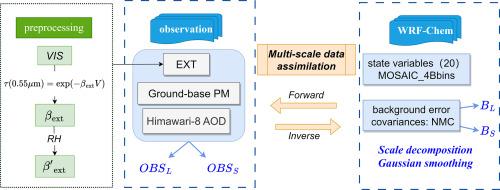利用WRF-chem的能见度资料同化改进气溶胶预报:方法和评价
IF 4.4
2区 地球科学
Q1 METEOROLOGY & ATMOSPHERIC SCIENCES
引用次数: 0
摘要
与传统的空气质量监测站相比,中国高密度能见度观测站的覆盖范围更加均匀,覆盖了城市、农村和偏远地区,提高了空间代表性。这些站点的能见度数据有可能优化空气质量模型中的气溶胶初始条件,从而提高污染预测的准确性。本研究详细介绍了与WRF-Chem模式集成的能见度观测同化模块的开发。我们的目标是吸收能见度数据,并评估与直接WRF-Chem模拟相比,通过同化实现的模型性能改进。同化系统采用先进的多尺度三维变分同化(MS-3DVAR)技术,并以WRF-Chem MOSAIC气溶胶物种浓度为控制变量。为了对能见度同化算法进行全面评估,我们对2021年3月中国北方沙尘事件的预报精度进行了三次数值试验。第一个实验(da_pm&aod)吸收了颗粒物(PM2.5和PM10)和卫星衍生的气溶胶光学深度(AOD)数据。第二个实验(DA_EXT)吸收了能见度数据,第三个实验(DA_ALL)综合了颗粒物、AOD和能见度数据。评价结果表明,控制试验组在沙尘事件中持续低估了该数值。DA_EXT同化组显著提高了PM10浓度和EXT(消光系数)的预报精度。在DA_PM&;AOD实验中,PM10模拟值与观测值的一致性指数提高到0.9以上。在DA_ALL实验中,EXT模拟的一致性指数达到0.677。结果表明,同化能见度数据对模型的初始气溶胶场和扬尘过程预测均有显著改善。这种增强补偿了可见光通道卫星观测的空间和时间不连续性。本文章由计算机程序翻译,如有差异,请以英文原文为准。

Improving aerosol forecasting through visibility data assimilation in WRF-chem: Methodology and evaluation
Chinese high-density visibility observation stations provide more uniform coverage than traditional air quality monitors, spanning urban, rural, and remote areas, which improves spatial representativeness. The visibility data from these stations has the potential to optimize aerosol initial conditions in air quality models, thereby improving the accuracy of pollution forecasting. This study details the development of a visibility observation assimilation module integrated with the WRF-Chem model. We aim to assimilate visibility data and evaluate the improvement in model performance achieved through assimilation compared to a direct WRF-Chem simulation. The assimilation system utilizes an advanced multi-scale three-dimensional variational assimilation (MS-3DVAR) technique and employs WRF-Chem MOSAIC aerosol species concentrations as control variables. To extensively evaluate the developed visibility assimilation algorithm, we conducted three numerical experiments focused on the forecasting accuracy of dust events that occurred in Northern China in March 2021. The first experiment (DA_PM&AOD) assimilated particulate matter (PM2.5 and PM10) and satellite-derived aerosol optical depth (AOD) data. The second experiment (DA_EXT) assimilated visibility data, while the third experiment (DA_ALL) integrated particulate matter, AOD, and visibility data. The evaluation demonstrates that, the control experiment group consistently underestimated the values during dust events. The DA_EXT assimilation group significantly improved the forecast accuracy of PM10 concentration and EXT (extinction coefficient). In the DA_PM&AOD experiment, the agreement index between PM10 simulation and observation increased to above 0.9. In the DA_ALL experiment, the agreement index for EXT simulation reached 0.677. The evaluation reveals that assimilating visibility data significantly improves both the initial aerosol fields and dust process forecasting in the model. This enhancement compensates for spatial and temporal discontinuities in satellite observations of visible light channels.
求助全文
通过发布文献求助,成功后即可免费获取论文全文。
去求助
来源期刊

Atmospheric Research
地学-气象与大气科学
CiteScore
9.40
自引率
10.90%
发文量
460
审稿时长
47 days
期刊介绍:
The journal publishes scientific papers (research papers, review articles, letters and notes) dealing with the part of the atmosphere where meteorological events occur. Attention is given to all processes extending from the earth surface to the tropopause, but special emphasis continues to be devoted to the physics of clouds, mesoscale meteorology and air pollution, i.e. atmospheric aerosols; microphysical processes; cloud dynamics and thermodynamics; numerical simulation, climatology, climate change and weather modification.
 求助内容:
求助内容: 应助结果提醒方式:
应助结果提醒方式:


